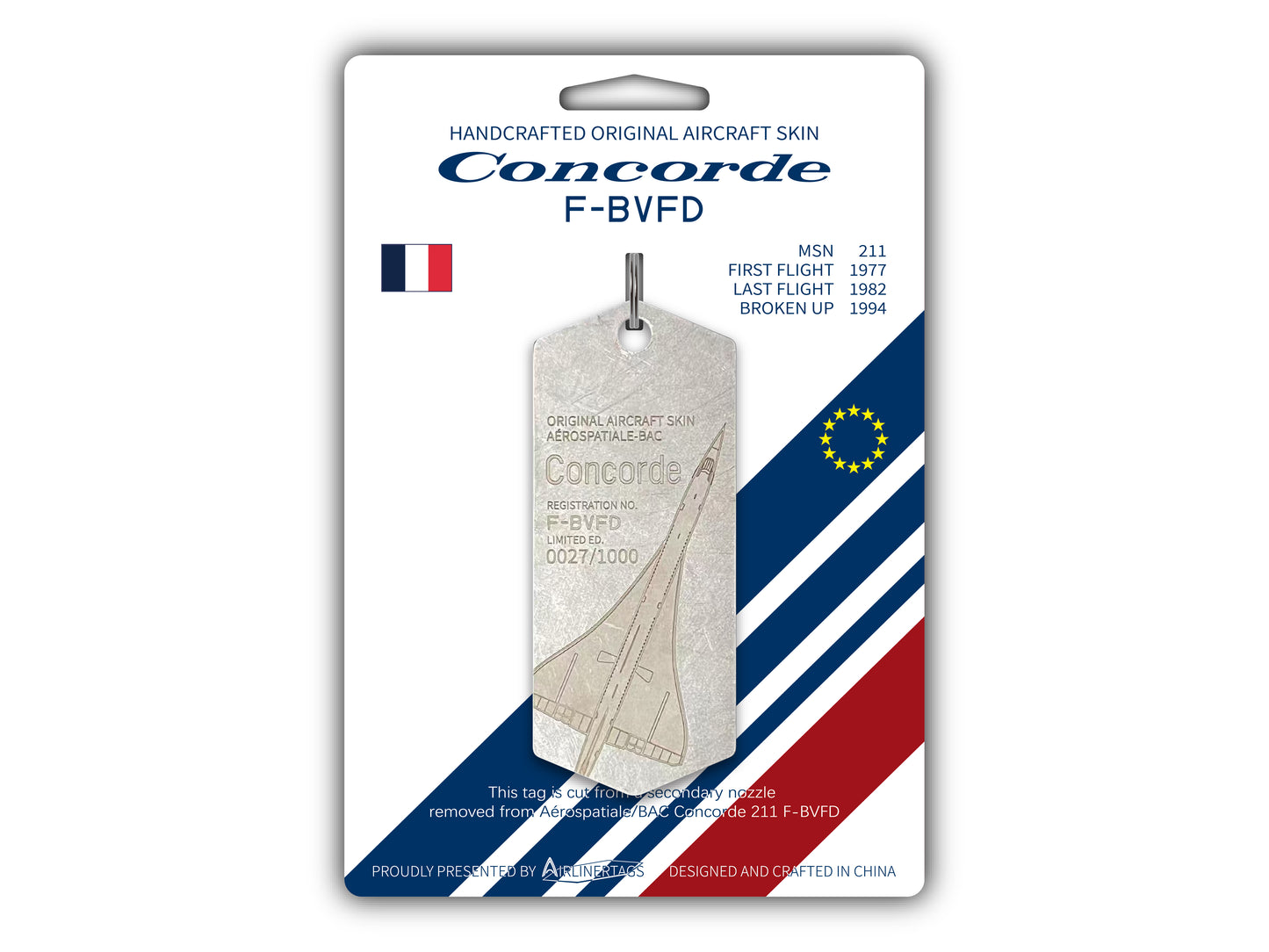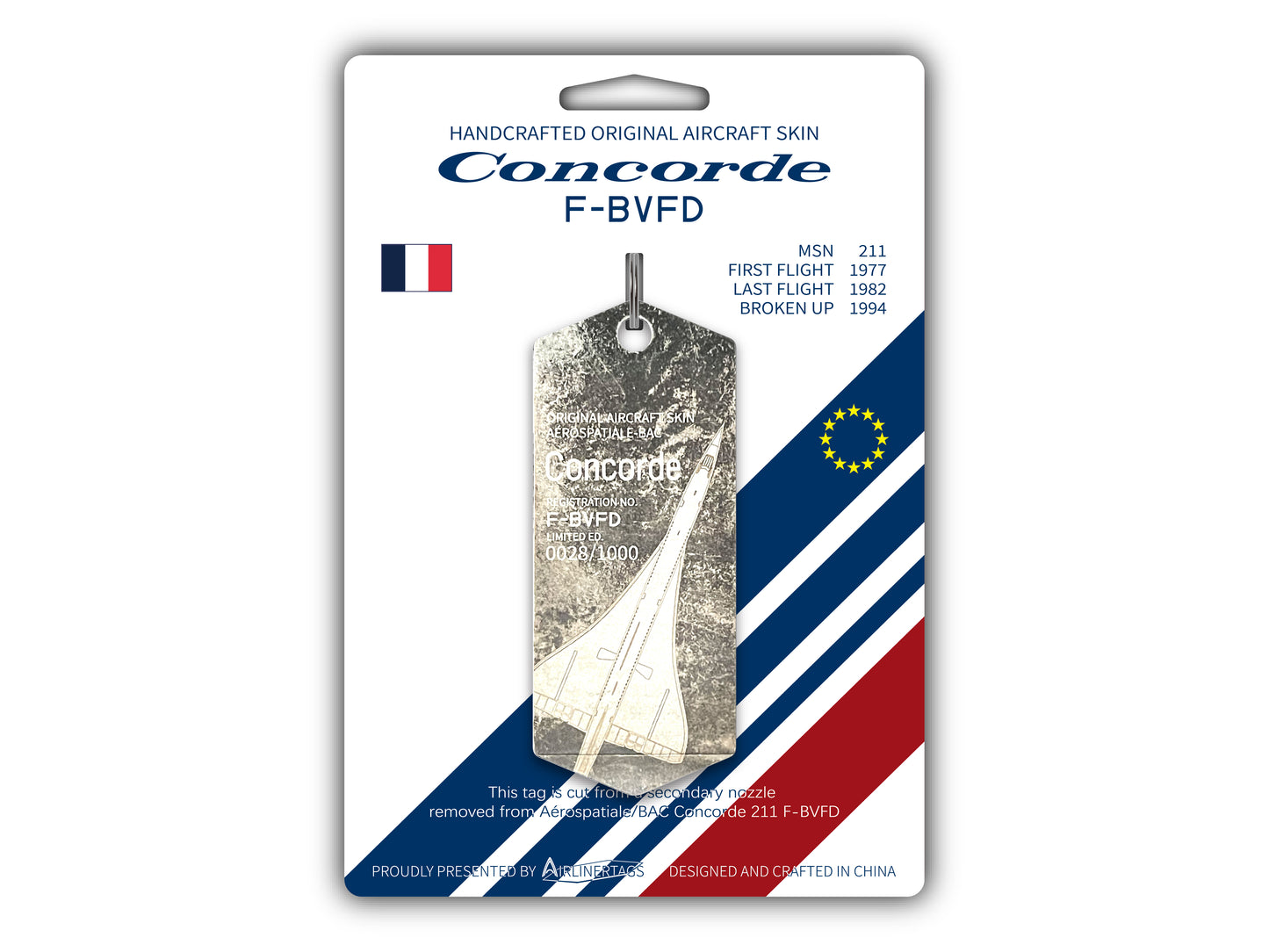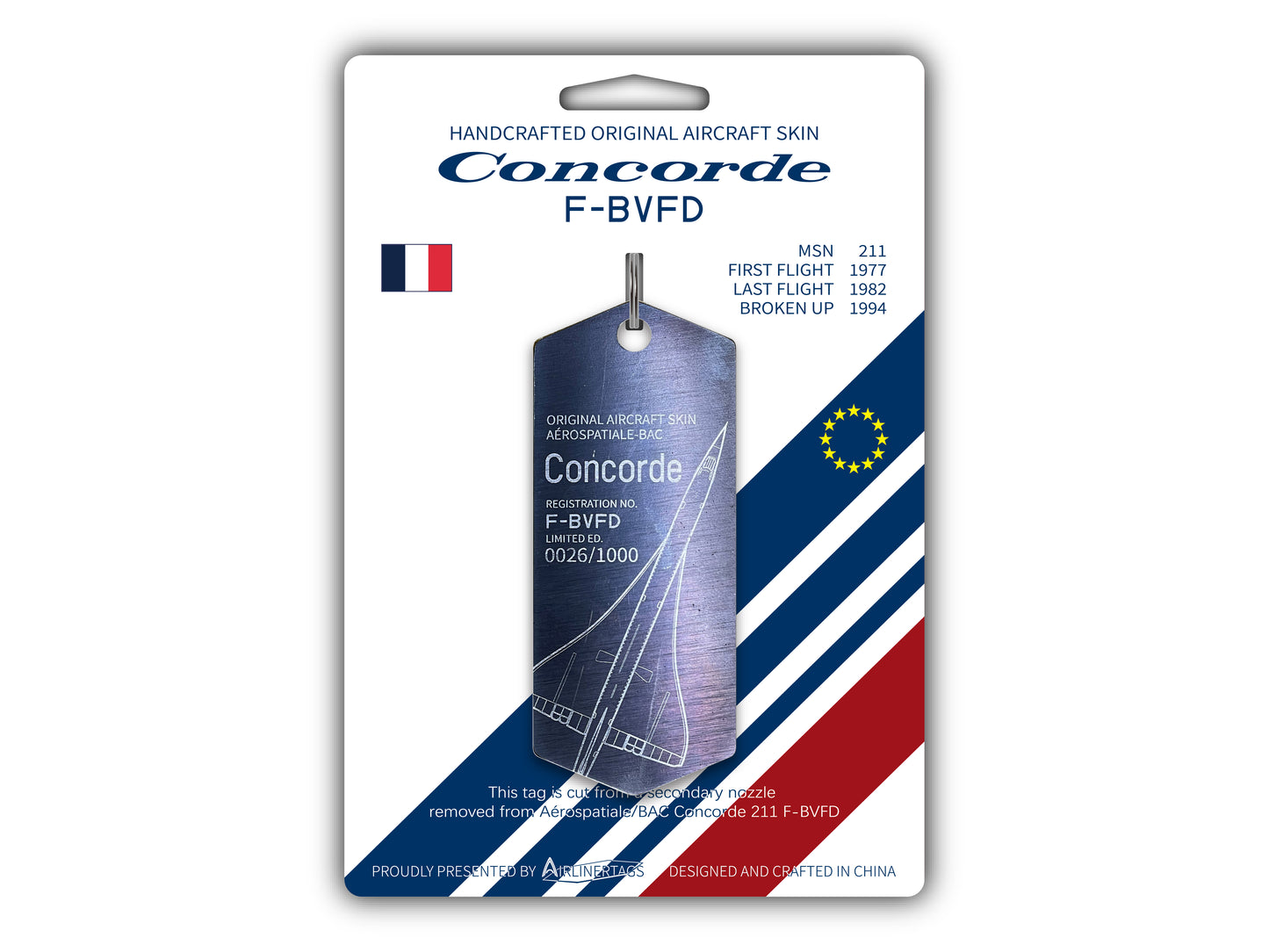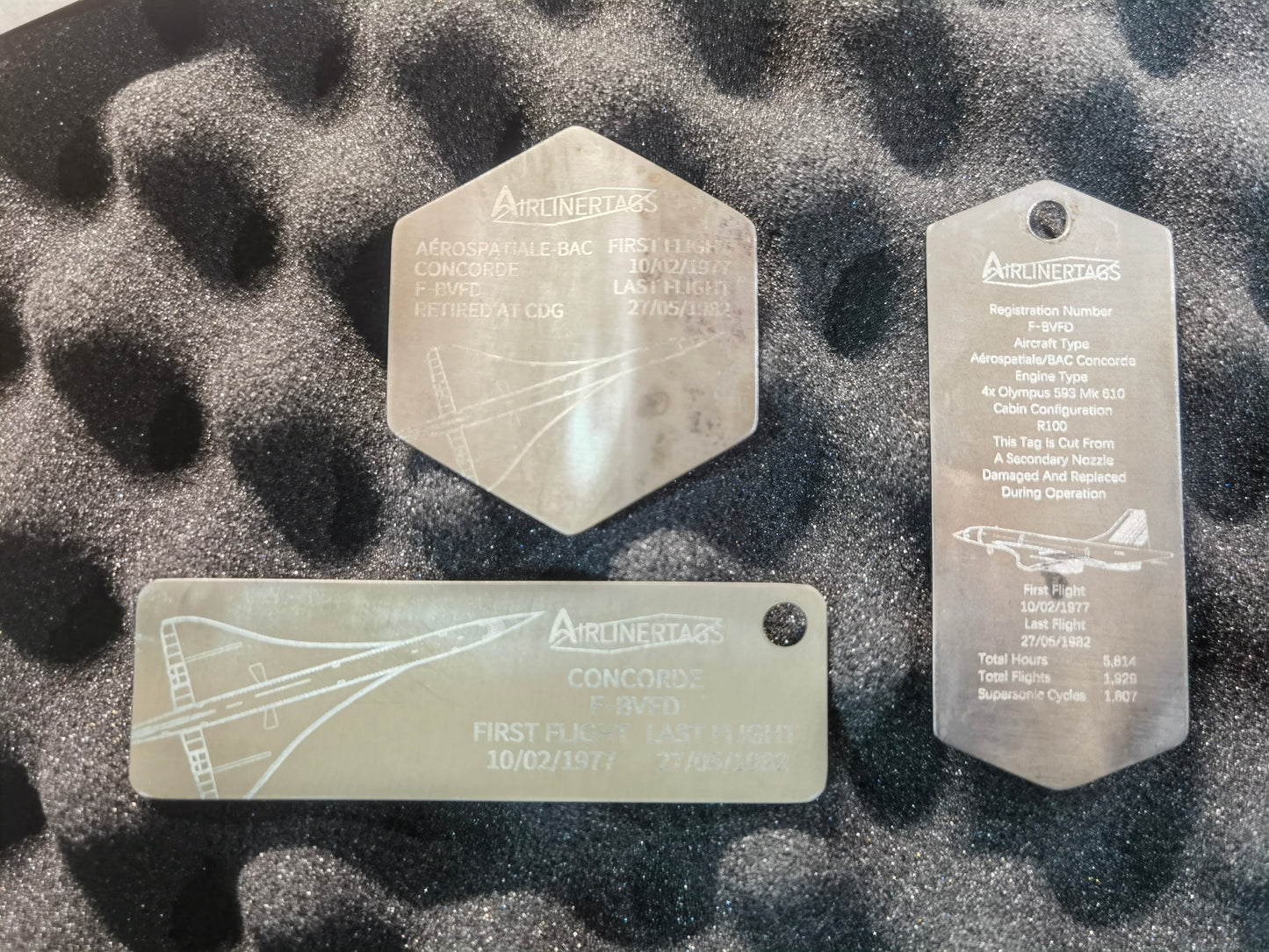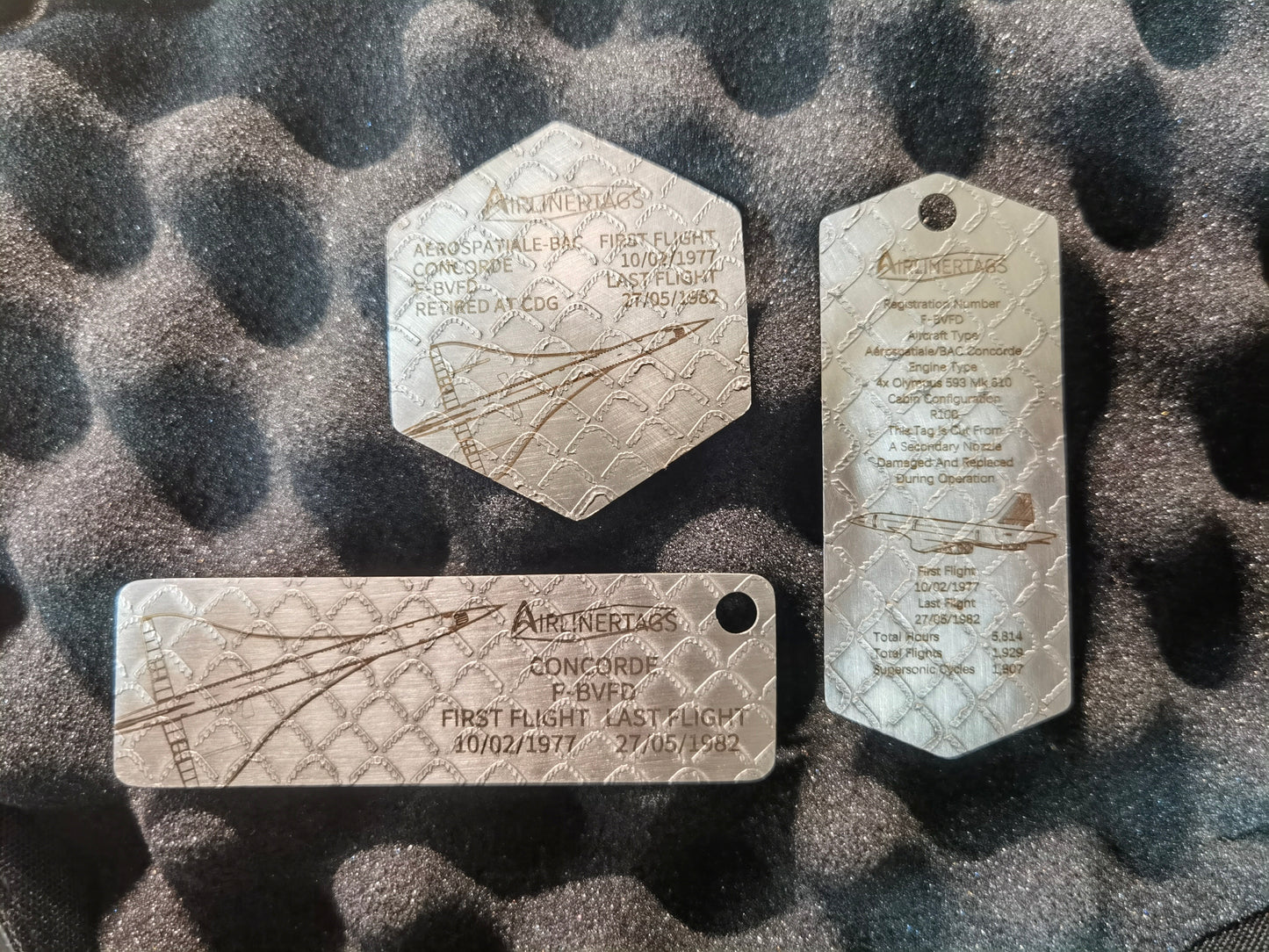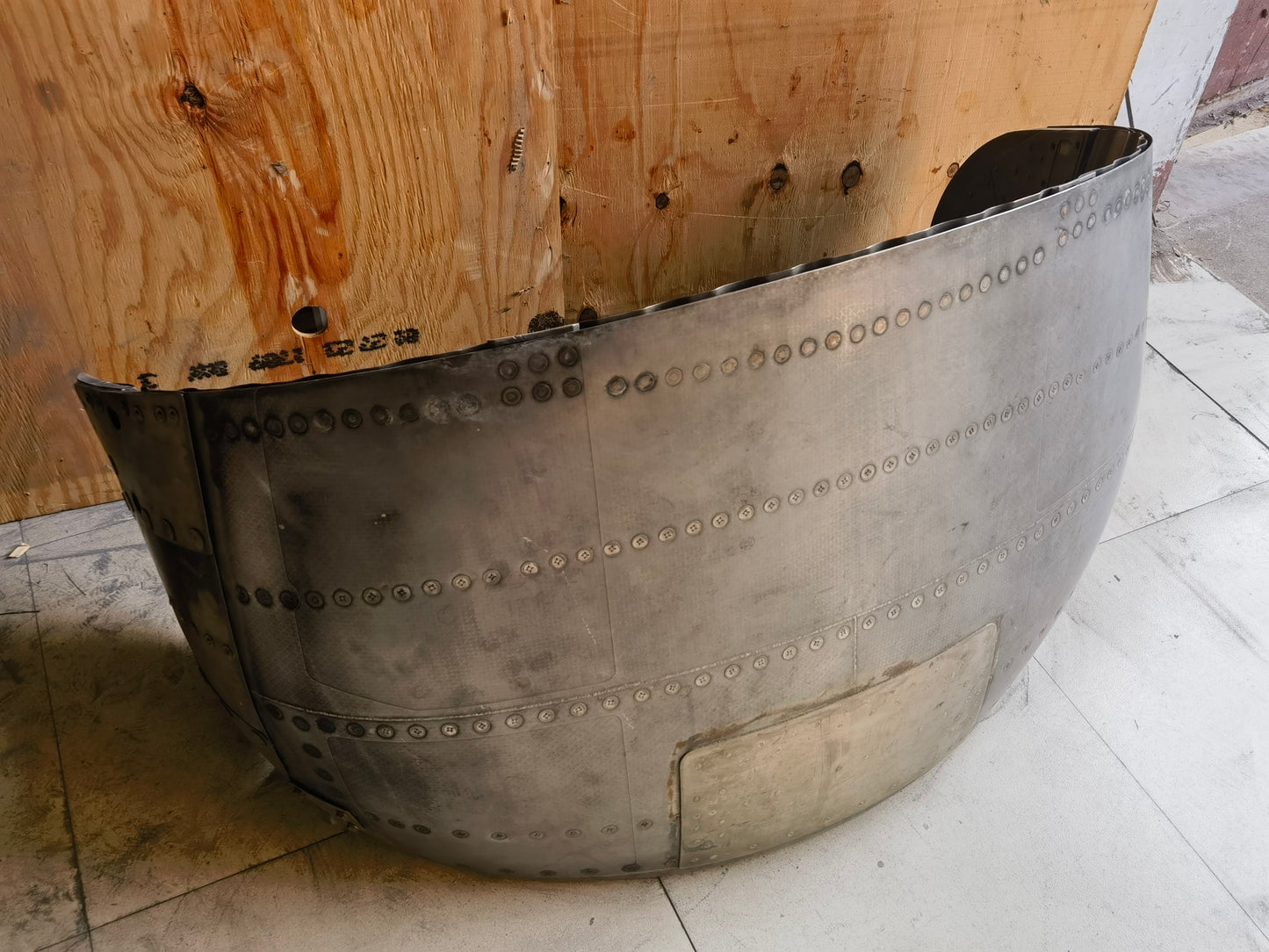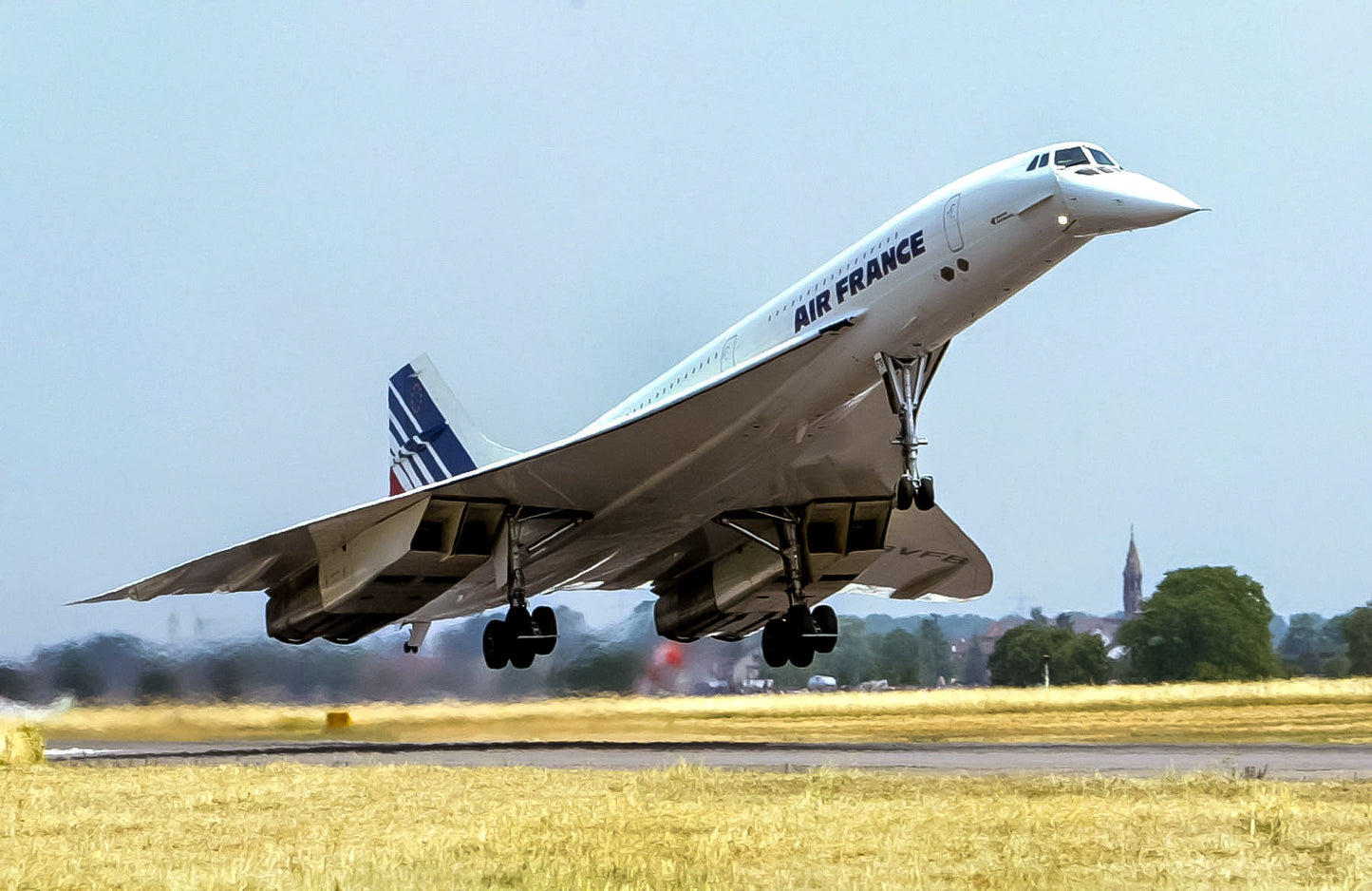Replaced Aircraft Parts
Aérospatiale Concorde ex-F-BVFD
Aérospatiale Concorde ex-F-BVFD
Couldn't load pickup availability
Earn [points_amount] when you buy this item.
GETTING YOUR RECTANGULAR TAGS FROM HERE
GETTING YOUR HEXAGONAL TAGS FROM HERE
Note
-
Special Tags are coming with special colour, special thickness, or special component.
- Special Tags will be distributed randomly with one of the speciality.
- The shade of Special Tags varies from violet, bronze to green in different light conditions. Please refer to the actual tag you receive.
- Non-Special Tags will HAVE a honeycomb shaped back; Special Tags will NOT HAVE a honeycomb shaped back.
Description
Handcrafted original aircraft skin from a lower rudder of BAC Concorde.
The Aérospatiale/BAC Concorde is a supersonic airliner jointly developed and manufactured by Sud Aviation (later Aérospatiale) and the British Aircraft Corporation (BAC). Concorde was the most technically ambitious project in aviation history, the bullet-shaped fuselage and futuristic delta wings made it possible to break the sound barrier with its 4 Rolls-Royce/Snecma Olympus 593 Mk 610 turbojet engines. As the most recognizable and iconic airliner in history, Concorde served as a symbol of pride for the British and the French.
On 10 February 1977, the French-made Concorde 211 took its first flight at Toulouse. The airliner was then delivered to Air France as F-BVFD on 26 March and started its career flying to Rio de Janeiro via Dakar as flight AF025. Instead of flying to New York, a second route Paris-Caracas, Venezuela via Santa Maria in the Azores started since 9 April 1976. These routes were compromises under the U.S. restriction of Concorde due to the public concern of the potential noise issue. Although the permission for Paris-Washington service was given 24 May 1976, it was already 17 October 1977 when the ban of Concorde landing at New York JFK was finally lifted by the U.S. Supreme Court.
On 22 November 1977, F-BVFD took off from Paris Charles de Gaulle Airport at 11:12 local time as AF002 and landed at New York John F. Kennedy International Airport at 08:47 local time, marking the first ever scheduled Concorde flight to JFK in 3 hour 35 minutes, even faster than the rotation of the earth. However, while everyone expecting a glorious career for 'Fox Delta', the airliner had a leavy landing and tailstrike at Dakar on 28 November, just six days after the historic JFK maiden flight. The landing was at 14 feet per second against the standard 10 fps limit, crushing the rear tail bumper wheel and scraping the rear of the engines over several hundred feet.
The thrust reverser buckets of Concorde, also known as secondary nozzles or eyelids, were located at the rear of the engine exhausts. With the abnormal high angle of attacks in a tailstrike scenario, the eyelids could touch the runway. In this case, the high landing speed of Concorde and the high descending rate of the heavy landing consequently caused damages to the eyelids of F-BVFD. A metal patch was later attached to the nozzles to meet the requirements of the Concorde Maintenance Manual chapter 78-31-01. After all the repair works were finished, F-BVFD was put back into service.
On 12 January 1979, the airliner was re-registered N94FD for Braniff Airways to comply with the regulations for domestic flights Washington-Dallas-Washington following the arrival from Paris. Unluckily, the poor 'Fox Delta' ran into several more incidents in 1979 probably due to the increase of usage. On 21 July 1979, a tire burst caused a compressor stall at FL270; On 23 September 1979, the No.3 tire/wheel and No.3 engine were damaged by a tread loss landing at Dakar and had to be replaced; Even worse, the right main landing gear hit two deer landing at Washington on 5 November 1979, causing damage to No.4 engine blades. On 1 June 1980, the airliner returned into the Air France fleet, being F-BVFD again.
In 1982, Air France ended their Paris-Dakar-Rio and Paris-Washington Concorde services due to financial reasons. As a result, one out of the seven Air France Concordes was not needed any more. F-BVFD was chosen as the one since the potential structural damage history and extra weight installed. The misfortuned airliner was withdrawn from use on 27 May 1982 and stored at Paris since, providing parts for other Air France and British Airways Concordes. During the short career of 'Fox Delta', the airframe accumulated 5,814 airborne hours in 1,929 cycles, including 1,807 supersonic flights. In 1994, the engineless corroding airframe of F-BVFD was eventually broken up, only a few pieces remaining today.
Recently, we found a secondary nozzle of the production-type Concorde in France, the nozzle was saved by a former Snecma engineer. With the further dismantle of the nozzle, we found some text saying a component was made in March 1976, ruling out three of the seven production-type Air France Concordes (F-BTSC, F-BVFA and F-BVFB). Since it is usually six months to a year between the production of parts and maiden flight of a Concorde, it is relatively safe to exclude the 1978-made F-BTSD and F-BVFF, leaving F-BVFC and F-BVFD as possible airframes.
Furthermore, considering the fact that the nozzle comes with a patch on the front edge, meaning the damage was made while extended during a landing instead of a taking off, and the nozzle shows very limited high-speed high-temperature air flow erosion comparing to the ones in museums, leading to the conclusion that the nozzle had a short service life instead of flying for decades, to our best knowledge, although not 100.00% sure, but the nozzle was highly likely to be removed from F-BVFD.
Based on the facts, evidence and our deductions, the nozzle perfectly matches the history of F-BVFD, that is why we decided to consider this nozzle as a piece of it. Ladies and gentlemen, from now on the forgotten F-BVFD is back as these Airlinertags!
More information about Airlinertags
More information about Airlinertags
Weight : around 0.03kg per tag
Size : (Hexagon) 52mm*60mm in square size
(Rectangle) 95mm*30mm
(HUD) 88mm*35mm
Important to read before purchasing
Important to read before purchasing
Unique Serial Numbers:
Each tag comes with its own distinct serial number, ensuring that every tag is special and unique. The serial numbers are assigned randomly, guaranteeing that you receive a different one with each purchase.
The photos provided serve as a reference for the product's design. Please note that the serial number you receive will not be identical to the one shown in the picture.
Multicolour Tags:
If you choose to purchase multicolour tags, each tag will feature a unique pattern by the location of the cuts are made. The variety in patterns adds an extra touch of individuality to your collection, with each tag being distinct.
The photos provided serve as a reference for the product's colour(s). Please note that the colour pattern you receive will not be identical to the one shown in the picture.
Aircraft Skin Origins:
Our aircraft skins have a rich history, having been flown with the aircraft for years before being parked in Boneyards, or during cargo conversions. We then handcraft these skins into tags. It's important to note that minor scratches and paint drops are normal due to their previous life.
Tag Usage Recommendations:
Hexagons and multicolour rectangle tags are not recommended for use as keychains. However, all rectangle tags come with a ring for daily use, providing convenience and durability.
Packaging Details:
Your package will include a cardboard piece alongside the tag. The hole and rings provided are designed to easily connect the two components, ensuring a secure and organized presentation.
Contact Us:
If you have any questions or need more details, feel free to contact us. We're here to assist you and provide the information you need.
Authenticity of Airlinertags
Authenticity of Airlinertags
At Airlinertags, authenticity is at the core of our product offering. We source our materials directly from boneyards and aircraft maintenance facilities worldwide, obtaining genuine aircraft skins that have weathered the skies and witnessed the stories of countless journeys.
Each keyring we create is a testament to the rich history and unique character of these aircraft skins. Our meticulous handcrafting process ensures that every tag preserves the integrity and authenticity of the original material, bringing a piece of aviation history into your hands.
When you hold an Airlinertags keyring, you're not just carrying a functional accessory – you're holding a piece of the aviation legacy. The marks, scratches, and imperfections on the aircraft skins tell a story of their own, making each keyring a distinctive and genuine artifact.
Experience the authenticity of aviation with Airlinertags – where every keyring is a tangible connection to the skies and the journeys these aircraft have undertaken.
Shipment Methods
Shipment Methods
Shipping Options: Economy and Express
Shipments are available with "Economy" (availability subject to service area) or "Express" option(s), postage and availability are listed during checkout. At [Your Store Name], we understand the importance of timely and reliable shipping. That's why we offer two convenient shipping options to cater to your needs – Economy and Express.
1. Economy Shipping by NextSmartShip:
Our Economy shipping option is fulfilled in partnership with NextSmartShip, a trusted and efficient warehouse partner. Here's what you can expect with our Economy shipping:
- Processing Time: Your order will be processed and prepared for shipment from our factory to the NextSmartShip warehouse.
- Delivery Time: Once your order reaches the NextSmartShip warehouse, it will be dispatched using an economical shipping method to your destination.
- Tracking: A tracking number will be provided by NextSmartShip, allowing you to monitor the progress of your shipment.
2. Express Shipping by DHL or UPS:
For those who need their orders expedited, we offer Express shipping through carriers like DHL or UPS. Here's what the Express shipping option details:
- Processing Time: Similar to Economy, your order will be processed and sent to the NextSmartShip warehouse.
- Delivery Time: Once at the NextSmartShip warehouse, your order will be expedited using DHL or UPS for a faster delivery to your doorstep.
- Tracking: Initially, a tracking number will be provided by NextSmartShip. If you've selected Express shipping and wish to track your order directly with DHL or UPS, simply contact us, and we'll provide you with the relevant tracking information once it is available.
How They Work:
1. Order Placement: After placing your order, it will be processed at our factory.
2. Transfer to NextSmartShip: Your products will be sent to our warehouse partner, NextSmartShip, for handling overseas shipping.
3. Shipment Dispatch: Depending on your chosen shipping option, your order will be dispatched either through the economical route or expedited with DHL or UPS.
4. Tracking Information: Track your order's journey using the provided tracking number. For Express customers, feel free to contact us for DHL or UPS tracking details.
At Airlinertags, we strive to provide a seamless and transparent shipping experience. If you have any questions or concerns, our customer support team is ready to assist you.
Thank you for choosing Airlinertags – where we provide you the best aircraft history in the world!
Disclaimer
Disclaimer
All companies (except Brussels Airlines®, British Airways®, BOAC® and associated names) and product names, trademarks and registered trademarks are the property of their respective owners and are used for identification purposes only. Airlinertags is not affiliated with, connected to or sponsored by any one of them.
Brussels Airlines® and associated names, emblems and logos are registered trademarks or trademarks in the Belgium and used under license.
British Airways®, BOAC® and associated names, emblems and logos are registered trademarks or trademarks in the UK and used under license.
